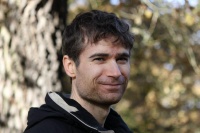CAZypedia needs your help! We have many unassigned GH, PL, CE, AA, GT, and CBM pages in need of Authors and Responsible Curators.
Scientists at all career stages, including students, are welcome to contribute to CAZypedia. Read more here, and in the 10th anniversary article in Glycobiology.
New to the CAZy classification? Read this first.
*
Consider attending the 15th Carbohydrate Bioengineering Meeting in Ghent, 5-8 May 2024.
Difference between revisions of "User:Darrell Cockburn"
Harry Brumer (talk | contribs) m (added link to Lexicon) |
|||
| Line 1: | Line 1: | ||
[[Image:Darrell1.jpg|200px|right]] | [[Image:Darrell1.jpg|200px|right]] | ||
| − | Darrell Cockburn received his BSc. and PhD from the University of Guelph in Ontario, Canada. During his PhD under his adviser ^^^Anthony Clarke^^^, Darrell primarily studied the structure function relationships within the endoglucanase family [[GH6]]. In 2010 Darrell moved to Denmark to take an H.C. Ørsted fellowship with ^^^Birte Svensson^^^ at the Technical University of Denmark. There he studied | + | Darrell Cockburn received his BSc. and PhD from the University of Guelph in Ontario, Canada. During his PhD under his adviser ^^^Anthony Clarke^^^, Darrell primarily studied the structure function relationships within the endoglucanase family [[GH6]]. In 2010 Darrell moved to Denmark to take an H.C. Ørsted fellowship with ^^^Birte Svensson^^^ at the Technical University of Denmark. There he studied [[Surface Binding Site]]s in a variety of carbohydrate active enzymes, with a particular focus on [[GH13]]. In 2013 Darrell moved to the University of Michigan to continue his Postdoctoral training with Nicole Koropatkin, studying the amylolytic systems of the gut bacteria ''Eubacterium rectale'' and ''Ruminococcus bromii''. |
---- | ---- | ||
Revision as of 09:49, 4 February 2015
Darrell Cockburn received his BSc. and PhD from the University of Guelph in Ontario, Canada. During his PhD under his adviser ^^^Anthony Clarke^^^, Darrell primarily studied the structure function relationships within the endoglucanase family GH6. In 2010 Darrell moved to Denmark to take an H.C. Ørsted fellowship with ^^^Birte Svensson^^^ at the Technical University of Denmark. There he studied Surface Binding Sites in a variety of carbohydrate active enzymes, with a particular focus on GH13. In 2013 Darrell moved to the University of Michigan to continue his Postdoctoral training with Nicole Koropatkin, studying the amylolytic systems of the gut bacteria Eubacterium rectale and Ruminococcus bromii.
- Cockburn DW, Orlovsky NI, Foley MH, Kwiatkowski KJ, Bahr CM, Maynard M, Demeler B, and Koropatkin NM. (2015). Molecular details of a starch utilization pathway in the human gut symbiont Eubacterium rectale. Mol Microbiol. 2015;95(2):209-30. DOI:10.1111/mmi.12859 |
-
Cockburn, D., Wilkens, C., Ruzanski, C., Andersen, S., Willum Nielsen, J., Smith, A.M., Field, R.A., Willemoës, M., Abou Hachem, M., and Svensson B. (2014) Analysis of surface binding sites (SBSs) in carbohydrate active enzymes with focus on glycoside hydrolase families 13 and 77 — a mini-review. Biologia, 69, 705-712. DOI: 10.2478/s11756-014-0373-9
-
Cockburn, D. and Svensson, B. Surface binding sites in carbohydrate active enzymes: an emerging picture of structural and functional diversity. 2013. In: Lindhorst TK, Rauter AP (eds) SPR carbohydrate chemistry—chemical and biological approaches, vol 39. Royal Society of Chemistry, Cambridge. DOI: 10.1039/9781849737173-00204
- Ruzanski C, Smirnova J, Rejzek M, Cockburn D, Pedersen HL, Pike M, Willats WG, Svensson B, Steup M, Ebenhöh O, Smith AM, and Field RA. (2013). A bacterial glucanotransferase can replace the complex maltose metabolism required for starch to sucrose conversion in leaves at night. J Biol Chem. 2013;288(40):28581-98. DOI:10.1074/jbc.M113.497867 |
-
Møller, M.S., Cockburn, D., Nielsen, J.W., Jensen, J.M., Vester-Christensen, M.B., Nielsen, M.M., Andersen, J.M., Wilkens, C., Rannes, J., Hägglund, P., Henriksen, A., Abou Hachem, M., Willemoës M., and B. Svensson (2013) Surface Binding Sites (SBS), Mechanism and Regulation of 2 Enzymes Degrading Amylopectin and α-limit Dextrins. J. Appl. Glycosci. EPub March 21. DOI: 10.5458/jag.jag.JAG-2012_023
-
Diemer, S.K., Svensson, B., Nygren Babol, L., Cockburn, D., Grijpstra, P., Dijkhuizen, L., Folkenberg, D.M., Garrigues, C., and R. Ipsen (2012) Binding interactions between α-glucans from Lactobacillus reuteri and milk proteins characterised by surface plasmon resonance. Food Biophys. 7: 220-226. DOI: 10.1007/s11483-012-9260-5
- Cockburn DW and Clarke AJ. (2011). Modulating the pH-activity profile of cellulase A from Cellulomonas fimi by replacement of surface residues. Protein Eng Des Sel. 2011;24(5):429-37. DOI:10.1093/protein/gzr004 |
- Quirk A, Lipkowski J, Vandenende C, Cockburn D, Clarke AJ, Dutcher JR, and Roscoe SG. (2010). Direct visualization of the enzymatic digestion of a single fiber of native cellulose in an aqueous environment by atomic force microscopy. Langmuir. 2010;26(7):5007-13. DOI:10.1021/la9037028 |
- Cockburn DW, Vandenende C, and Clarke AJ. (2010). Modulating the pH-activity profile of cellulase by substitution: replacing the general base catalyst aspartate with cysteinesulfinate in cellulase A from Cellulomonas fimi. Biochemistry. 2010;49(9):2042-50. DOI:10.1021/bi1000596 |
- Jing H, Cockburn D, Zhang Q, and Clarke AJ. (2009). Production and purification of the isolated family 2a carbohydrate-binding module from Cellulomonas fimi. Protein Expr Purif. 2009;64(1):63-8. DOI:10.1016/j.pep.2008.10.015 |
- Legaree BA, Daniels K, Weadge JT, Cockburn D, and Clarke AJ. (2007). Function of penicillin-binding protein 2 in viability and morphology of Pseudomonas aeruginosa. J Antimicrob Chemother. 2007;59(3):411-24. DOI:10.1093/jac/dkl536 |
